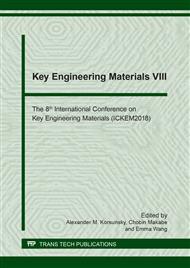[1]
Z.C. Moh, J.D. Nelson, E.W. Brand, Strength and deformation behaviour of Bangkok clay, Proceeding of the 7th International Conference on Soil Mechanics and Foundation Engineering, Mexico City, 1 (1969) 287-295.
Google Scholar
[2]
Asian Institute of Technology, Investigation of Land Subsidence Caused by Deep Well Pumping in the Bangkok Area, Phase II Final Report. AIT research report submitted to the National Environment Board, Thailand, (1980).
Google Scholar
[3]
W. Teparaksa, N. Thasnanipan, A. W. Maung, P. Tanseng, Lessons from the collapse during construction of an inlet pumping station: Geotechnical instrumentation aspect, Proceeding of the 5th International Symposium on Field Measurements in Geomechanics, Singapore. (1999).
Google Scholar
[4]
S. Horpibulsuk, W. Katkan, W. Sirilerdwattana, R. Rachan, Strength development in cement stabilized low plasticity and coarse grained soils: laboratory and field study, Soils and Foundations. 46 (2006) 351-366.
DOI: 10.3208/sandf.46.351
Google Scholar
[5]
S. Horpibulsuk, R. Rachan, A. Suddeepong, A. Chinkulkijniwat, Strength development in cement admixed Bangkok clay: laboratory and field investigations, Soils and Foundations. 51 (2011) 239-251. DOI: https://doi.org/10.3208/sandf.51.239.
DOI: 10.3208/sandf.51.239
Google Scholar
[6]
S. Horpibulsuk, W. Phochan, A. Suddeepong, A. Chinkulkijniwat, and M.D. Liu, Strength development in blended cement admixed saline clay, Applied Clay Science. 55 (2012) 44-52. DOI: https://doi.org/10.1016/j.clay.2011.10.003.
DOI: 10.1016/j.clay.2011.10.003
Google Scholar
[7]
T. Chompoorat, Dynamic properties of cement treated clay, The Seventh Asian Young Geotechnical Engineers Conference (7AYGEC(, Tokushima, Japan. (2012) 273-279.
Google Scholar
[8]
P. Julphunthong, Chemical Stabilization of Loess in Northeast Thailand Using the Mixture of Calcined Marble Dust Waste and Sugarcane Bagasse Ash Waste, Geotechnical Engineering Journal of the SEAGS & AGSSEA. 46 (2015) 103-108.
Google Scholar
[9]
T. Chompoorat and S. Likitlersuang, Assessment of shrinkage characteristic in blended cement and fly ash admixed soft clay, The 15th Asian Regional Conference on Soil Mechanics and Geotechnical Engineering, Japanese Geotechnical Society Special Publication. 2 (2016) 311-316.
DOI: 10.3208/jgssp.tha-01
Google Scholar
[10]
J. Kamau, A. Ahmed, P. Hirst, J. Kangwa, Suitability of Corncob Ash as a Supplementary Cementitious Material, International Journal of Materials Science and Engineering. 4 (2016) 215-228.
DOI: 10.24018/ejers.2018.3.7.785
Google Scholar
[11]
S. Ioannou, K. Paine, L. Reig, K. Quillin, Performance characteristics of concrete based on ternary calcium sulfoaluminate-anhydrite-fly ash cement, Cement and Concrete Composites. 55 (2015).
DOI: 10.1016/j.cemconcomp.2014.08.009
Google Scholar
[12]
I.A. Chen, M.C.G. Juenger, Synthesis and hydration of calcium sulfoaluminate-belite cements with varied phase compositions, Journal of Materials Science. 46 (2011) 2568-2577. DOI: https://doi.org/10.1007/s10853-010-5109-9.
DOI: 10.1007/s10853-010-5109-9
Google Scholar
[13]
P.K. Hou, J.S. Qian, Z. Wang, Ch. Deng, Production of quasi-sulphoaluminate cementitious materials with electrolytic manganese residue, Cement and Concrete Composites. 34 (2012) 248-254.
DOI: 10.1016/j.cemconcomp.2011.10.003
Google Scholar
[14]
A. Cuesta, Hydration mechanisms of two polymorphs of synthetic ye'elimite, Cement and Concrete Research. 63 (2014) 127-136. DOI: https://doi.org/10.1016/j.cemconres.2014.05.010.
DOI: 10.1016/j.cemconres.2014.05.010
Google Scholar
[15]
I.A. Chen, Incorporation of coal combustion residuals into calcium sulfoaluminate-belite cement clinkers, Cement and Concrete Composites. 34 (2012) 893-902. DOI: https://doi.org/10.1016/j.cemconcomp.2012.04.006.
DOI: 10.1016/j.cemconcomp.2012.04.006
Google Scholar
[16]
M.L. Pace, Use of industrial byproducts as alumina sources for synthesis of calcium sulfoaluminate cements, Environmental Science & Technology. 45 (2011) 6124-6128.
DOI: 10.1021/es2005144
Google Scholar
[17]
ASTM International, Standard test method for unconfined compressive strength of cohesive soil, ASTM D2166, Washington, D.C., (2000).
Google Scholar
[18]
S. Nontananandh, T. Thongdetsri, P. Kaewkaorop, J. Takemura, Stabilization of Seabed Dredged Sludges as Construction Materials, Proceeding of the Sixth Regional Symposium on Infrastructure Development (RSID6), Bangkok, Thailand. (2009) 45.
Google Scholar
[19]
C. Hu, D. Hou, Z. Li, Micro-mechanical properties of calcium sulfoaluminate cement and the correlation with microstructures, Cement and Concrete Composites. 80 (2017) 10-16. DOI: https://doi.org/10.1016/j.cemconcomp.2017.02.005.
DOI: 10.1016/j.cemconcomp.2017.02.005
Google Scholar


